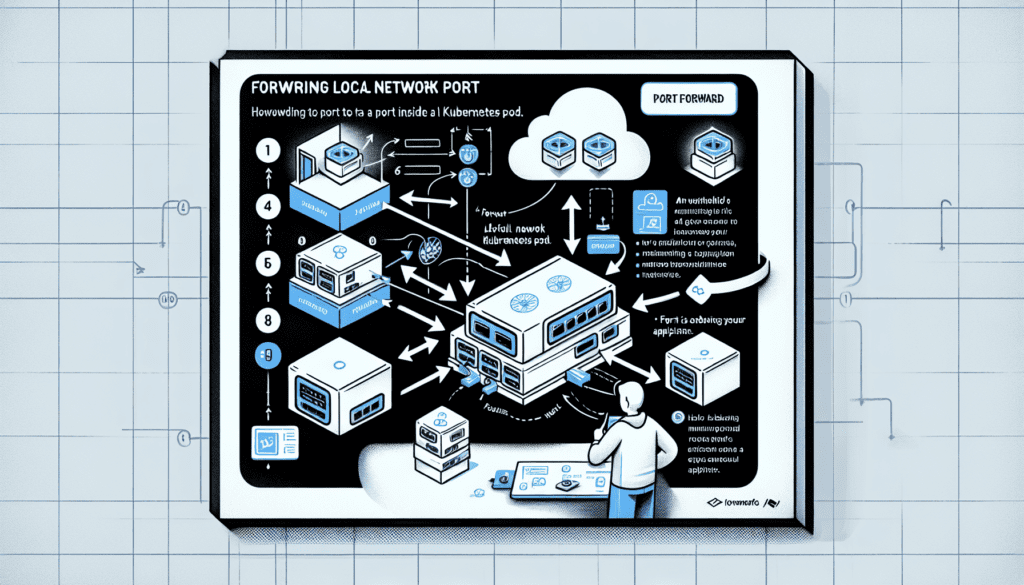In this article we look into the effective utilization of the Kubernetes port forward feature – kubectl port-forward. It covers the essential features of how it operates, its specific uses, as well as practical examples of its application. In addition, this piece also explores real-world scenarios where this feature shines, complete with illustrative code examples for a better grasp of the subject matter. By providing valuable insights into aspects such as the Kubernetes API server, Kubernetes services, local networks, docker containers, and network traffic management, among others, this article enables you to leverage this powerful tool to its fullest potential.

Understanding Kubernetes Port Forwarding
What Kubernetes Port Forwarding is
Kubernetes Port Forwarding is a powerful tool that allows users to manage network traffic by forwarding it from certain ports on a local machine to a port on a specific pod. This is a convenient method to connect the outside world with internal resources, thereby offering direct access to Kubernetes Pods.
How Kubernetes Port Forwarding Works
Quite simply, Kubernetes Port Forwarding allows you to establish a connection between your local system’s ports and the ports within a pod. A user sends a request from a local port which Kubernetes will then forward to the target pod. This is enabled through the local network traffic being directed to a specified pod.
The role of Kubernetes API Server in Port Forwarding
The Kubernetes API Server plays a critical role in facilitating port forwarding. When you create a port forwarding request, the Kubernetes API Server works as a middleware by creating an endpoint that can route the request to the correct pod and also establishes a secure tunnel for this traffic.
Setting Up The Environment
Importance of having a local machine
In the context of Kubernetes, a local machine provides a controlled environment to monitor and understand how certain services work. It also serves as a channel through which one can test code, explore Kubernetes features, and execute the necessary ports traffic.
Use of specific pod
In Kubernetes, a pod represents a group of one or more containers. When you’re executing port forwarding, the traffic from the specified local port becomes directed to your defined specific pod. This makes the use of a specific pod vital in the port-forward command operation in Kubernetes port forwarding.
Importance of Docker container for Kubernetes Services
Docker containers are crucial for Kubernetes Services because they provide a virtual machine alternative that is lightweight and has lower overhead costs. Containers can be efficiently managed, communicate seamlessly with Kubernetes Services, and provide a controlled environment to host applications, which is essential when working with Kubernetes port forwarding.
How to obtain a kubeconfig file
A kubeconfig file is required to establish and manage connections with Kubernetes clusters. You can configure it by setting up the ‘KUBECONFIG’ environment variable. Additionally, the ‘kubectl config use-context’ command will select the cluster for the next step.
Kubernetes Port Forwarding: The Basics
Importance of CLI requests
CLI, or Command-Line Interface, interface is vital in Kubernetes as it simplifies the process of sending requests, thus enabling quicker access to internal Kubernetes cluster processes.
Working with kubectl command-line tool
kubectl is the command-line tool that enables users to run commands against Kubernetes clusters. By using kubectl, tasks such as deploying applications, managing cluster resources, and viewing logs become intuitive and easy to execute.
Understanding the port-forward command
In Kubernetes, the ‘kubectl port-forward’ command allows you to forward connections from a local port to a port on a pod. This command provides a mechanism to access services running in the pod from the local system without exposing them to the public internet.
Decoding the local network and port number mechanic
The local network and port number essentially define where the traffic will originate. By identifying a local port number, you instruct Kubernetes where to forward traffic from your local network.
Introduction to secure tunnel and its role
In Kubernetes port forwarding, a secure tunnel is created to ensure the safety of data transmission between the local machine and the specific pod. The secure tunnel prevents unauthorized access and potential data breaches.

Working with Kubectl Port-forward Pod Command
Necessity of pod name for the command
In the ‘kubectl port-forward pod’ command, mentioning the pod name is essential as it directs the traffic flow. By specifying the pod name, you tell Kubernetes exactly which pod the traffic should be forwarded to.
Differences between different ports
In Kubernetes, each port has different roles. There are specific ports for transferring data, ports for receiving data, and even random ports dedicated to specific functions. Understanding how to work with different ports is essential to correctly setting up and managing your Kubernetes environment.
The effect of a running container on the port forward
After launching the ‘kubectl port-forward pod’ command, a new process is initiated and starts running a container with the desired port. This leads to the creation of a connection between the local system and the Kubernetes pod, thereby influencing the port forwarding.
Utilizing Kubernetes Port Forward For Local Development
Creating a direct connection to local machine
Kubernetes port forwarding allows developers to create a direct connection between the local machine and the Kubernetes pod. Not only does this allow for more significant control and flexibility, but it also simplifies processes related to local development and testing.
Adjusting network traffic for local environment
By adjusting network traffic, developers can control the flow of data to match their local network configurations. Kubernetes port forwarding allows you to use the ‘kubectl port-forward’ command to tailor data traffic to suit your specific development needs.
Port mapping specific namespace for local development
With Kubernetes port forwarding, you can easily map specific namespaces to a port. This is valuable during local developments as it allows the isolation and exclusive use of certain components, giving developers more control over their environment.
Dealing with Kubernetes Services via Port Forwarding
The role of load balancer and public internet
In Kubernetes, the load balancer distributes network traffic efficiently across multiple servers to ensure optimal resource usage. When the traffic is forwarded through a public internet connection, the load balancer effectively keeps your application running smoothly during heavy traffic.
Creating a service account
Creating a service account in Kubernetes will increase security as this account has restricted permissions. This provides a way to control who can access the cluster’s resources, ensuring the integrity of your forward ports service.
Forwarding ports to external services
With Kubernetes port forwarding, you can easily forward ports to external services. This enables applications to communicate with services that are outside of the Kubernetes cluster.
Advanced Port Forwarding Techniques
Understanding the importance of a specific port
When working with advanced port forwarding techniques, understanding the role and function of a specific port is crucial. The right port can regulate the flow of data, making it a determining factor in ensuring successful data transmission.
Using Network Interface with Kubernetes Pod
By using a network interface with a Kubernetes pod, you can control the flow of data more accurately. This offers the ability to isolate traffic, ensuring that only selected nodes receive specific data packets.
Setting up HTTPS connections and deployment name
Setting up HTTPS in Kubernetes ensures secure connections, protecting sensitive data in transit. Specifying the deployment name on the other hand, helps Kubernetes direct traffic to the proper deployment.
Understanding Error Handling and Troubleshooting
Determining problems with a single HTTP connection
Kubernetes port forwarding deals primarily with HTTP connections. Therefore, understanding how to troubleshoot a problematic HTTP connection is crucial. By examining the logs and error messages, you can determine the source of the issue and apply a suitable fix.
Dealing with the process id
In the event of an error occurring during Kubernetes port forwarding, dealing with the process id is often necessary. If a forwarding process is terminated abruptly, finding the process id can help identify the problems and aids in re-establishing the connection.
Understanding the server version and server’s certificate
Knowing your server version helps when troubleshooting issues as it allows you to understand its capabilities and limitations. On the other hand, ensuring the server’s certificate is valid and updated ensures secure connections and data protection.
Security Considerations for Port Forwarding
Importance of client key file and client version
For secure port forwarding in Kubernetes, the client key file and the client version are extremely important. The client key file helps establish a secure connection while the client version helps identify the commands available for use and their specific functionalities.
Working with Service Account for secured operation
To secure Kubernetes port forwarding operations, a Service Account is essential. This account provides an identity for processes that run in a pod, helping maintain the security and integrity of your system.
External network and external port: understanding public access
In Kubernetes port forwarding, understanding public access to your external network and external port is crucial for maintaining security. Limiting public access prevents unauthorized users from gaining access to your system’s internal resources.
Real-World Use Cases and Examples
Potential real-world uses of Kubernetes port forwarding
Kubernetes port forwarding is practical for a wide range of real-world applications. For instance, developers can use it to test applications in a controlled environment, database administrators can manage databases more securely, and system administrators can smoothly monitor system performance.
Creating specific use case scenarios
Understanding how to create specific use case scenarios gives you insights into how Kubernetes port forwarding can be used in practical situations. For example, in a scenario where developers need to access a database hosted in a Kubernetes cluster, they can port forward the database port to their local machine where they can securely access and manage the database.
Quick access to internal Kubernetes cluster processes
Kubernetes port forwarding simplifies the process of gaining quick access to internal Kubernetes cluster processes. By establishing a direct connection to a service running inside a Kubernetes cluster, developers can expedite their work processes.
Analyzing the difference between regular user and name of the kubeconfig cluster
When working with Kubernetes, it is important to understand the difference between a regular user and the name of the kubeconfig cluster. While a regular user typically has system-wide access, the kubeconfig identity allows access that is limited to specific commands, thus reducing the risk of inadvertent changes or breaches.



